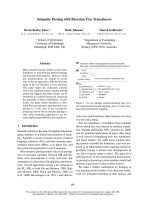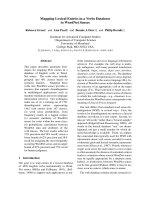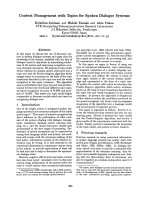báo cáo khoa học: " Threshold models with heterogeneous residual variance due to missing information" doc
Bạn đang xem bản rút gọn của tài liệu. Xem và tải ngay bản đầy đủ của tài liệu tại đây (189.18 KB, 6 trang )
Note
Threshold
models
with
heterogeneous
residual
variance
due
to
missing
information
I.
MISZTAL
D.
GIANOLA
Ina
HOESCHELE
University
of
Illinois,
Department
of Animal
Sciences,
Urbana,
IL
61801,
USA
**
Warsaw
Agricultural
University,
Department
of
Animal
Sciences
(SGGW-AR),
Przejazd
4,
OS-840
Brwinow,
Poland
***
Virginia
Polytechnic
Institute
and
State
University,
Department
of
Dairy
Science,
Blacksburg,
VA
24061,
USA
Summary
Threshold
model
equations
are
modified
to
account
for
unequal
variances
of
residual
effects
in
the
underlying
scale.
Modifications
are
simple
and
can
be
easily
incorporated
in
programs
that
conduct
a
threshold
model
analysis
under
the
usual
assumption
of
homoscedasticity.
Key
words :
threshold
model,
sire
evaluation,
heterogeneous
variance.
Résumé
Les
modèles
à
seuils
à
variance
résiduelle
hétérogène
du
fait
d’une
information
incomplète
Les
équations
relatives
au
modèle
à
seuils
peuvent
être
modifiées
afin
de
prendre
en
compte
des
variances
résiduelles
inégales
des
effets
mesurés
sur
l’échelle
sous-jacente.
Les
modifications
à
apporter
sont
simples
et
peuvent
être
aisément
incorporées
dans
les
programmes
effectuant
une
analyse
par
modèle
à
seuil
sous
l’hypothèse
habituelle
d’homoscédasticité.
Mots
clés :
modèle
à
seuil,
évaluation
des
pères,
variance
hétérogène.
I.
Introduction
Threshold
model
equations
(G
IANOLA
&
F
OULLEY
,
1983 ;
H
ARVILLE
&
M
EE
,
1984)
were
originally
derived
assuming
that
the
residuals
of
the
model
for
the
underlying
normal
variable
have
constant
variance.
This
may
not
be
true
in
general.
Also,
even
if
the
assumption
holds,
there
are
certain
genetic
evaluation
models
where
lack
of
some
information
leads
to
heterogeneity
of
residual
variance.
For
example,
consider
a
sire -
maternal
grandsire
model
(E
VERE
TT
et
al.,
1979 ;
Q
UAAS
et
al.,
1979).
Here,
the
residual
variance
depends
on
whether
or
not
the
sire
or
maternal
grandsire
is
identified.
If
any
of
these
ancestors
is
not
identified,
its
effect
is
not
included
in
the
model,
but
its
variance
is
added
to
that
of
the
residual
effect.
A
similar
problem
arises
in
«
reduced
»
animal
models
(Q
UAAS
&
P
OLLAK
,
1980),
when
the
dam
is
not
identified.
The
objective
of
this
note
is
to
present
modifications
of
the
threshold
model
equations
needed
to
account
for
varying,
but
known,
residual
variance.
II.
Methods
Consider,
for
example,
a
sire-maternal
grandsire
model.
This
can
be
written
as :
where
Y¡jk
is
an
observation
on
individual
k,
with
sire
i and
maternal
grandsire
j.
The
scalars s
;
and 2 1 s,
are
the
random
effects
of
sires
and
maternal
grandsires,
respectively,
and
(3
is
a
vector
of
fixed
effects,
which
relate
to
Y¡jk
via
the
incidence
vector
x
ii,.
In
practical
applications,
the
pedigree
may
be
incomplete
so
the
identification
of
the
sire
or
of
the
maternal
grandsire
may
be
missing.
In
these
cases,
one
can
define
a
«
generalized
» residual,
c
ij,,
which
can
take
the
values :
if
the
sire
is
missing,
if
the
maternal
grandsire
is
missing.
In
the
threshold
model,
due
to
non-observability
of
y
ij,,
it
is
assumed
that
0
-;
=
1,
so
all
parameters
and
random
variables
are
expressed
in
units
of
residual
standard
deviation.
Thus,
depending
on
the
situation :
With
this
in
mind,
the
underlying
variable
in
the
threshold
model
can
be
written
as :
!
where
u
includes
both
sire
and
maternal
grandsire
effects,
and
z¡
is
an
incidence
vector
with
elements
appropriately
defined
to
take
into
account
presence
or
absence
of
the
effect.
As
usual
(G
IANOLA
&
F
OULLEY
,
1983) :
and
now
where
CT7 = 1,
1
+
o!,
or
1
+ !
o!,
depending
on
the
situation.
4
Let
m
be
the
number
of
categories
as
described
by
G
IANOLA
&
F
OULLEY
(GF,
1983)
and
H
ARVILLE
&
M
EE
(1984).
The
conditional
probability
that
observation j
is
in
category
k,
given
IL¡,
can
be
written
as :
’
where
t,
<
t2
<
< t.
-,
is
a
set
of
fixed
thresholds
which
partition
the
real
line
into
m
mutually
exclusive
and
exhaustive
intervals.
The
log
posterior
density
function
of
9’ =
(t’,(3’,u’), with
t
being
the
vector
of
thresholds
is :
where
s is
as
in
GF.
This
function
is
then
maximized
with
respect
to
0
using
Fisher’s
scoring
algorithm :
where
[i]
is
round
number
and
4
1il
=
6
lil
-
6
1H
I.
Let
at,
=
6/u
¡,
and
note
that
P,,
in
[6]
is
as
in
GF,
but
allows
for
heterogenous
variance.
Then :
This
vector
is
exactly
as
in
GF
except
for
two
aspects :
(1)
the
scalar
o-
’’
appears,
and
(2)
P
ik
is
evaluated
as
in
[6],
as
opposed
to
taking
(Ii
=
1
for
all
observations.
Thus :
where
p*
and
v*
are
similar
to
p
and
v
in
GF :
Similarly,
the
second
derivatives
of
L(0)
with
respect
to
0
can
be
written
as :
Again,
this
matrix
is
as
in
GF
except
for
the
factor
o,,’
and
with
P
I-
calculated
as
in
[6].
Hence,
after
taking
expectations
in
Fisher’s
scoring :
where
each
element
of
T*, L*,
and
W*
is
evaluated
as
in
GF
with
the
following
mo-
difications :
(1)
replace <))
(t
k
-
1
1-)
by 40
[(t
k
-
11
-)/o
J,
(2)
calculate
P!k
as
in
[6],
(3)
multiply
each
elementary
term
(the
«
contribution
» of
each
row
in
the
contingency
table)
by
U
¡2.
Using
[10]
and
[12],
iteration
proceeds
with
[8].
From
a
computational
viewpoint,
it
is
useful
to
observe
that
[8]
is
usually
built
summing
«
contributions
» from
each
observation
or
each
row
in
the
contingency
table.
Let
q
¡-IJ
and
r¡
i-
II
be
the
«
contributions
» of
the
row j
in
round
i -
1 to
the
coefficient
matrix
and
the
right-hand
sides,
respectively.
The
modified
system
of
equations
is
then :
III.
Numerical
example
A
hypothetical
example
involving
two
unrelated
sires
from
the
same
population,
appearing
also
as
maternal
grandsires,
was
considered.
It
was
assumed
that
the
offspring
of
these
sires
were
recorded
in
the
same
testing
environment.
The
response
was
binary
and
the
15
observations
available
are
as
shown
below :
Because
of
the
assumptions,
fixed
effects
need
not
be
considered,
and
the
model
for
the
underlying
variable
is :
1
Above,
s;
and 2 s!
are
the
random
effects
of
sire
i
and
maternal
grandsire
j,
2
f
respectively.
Under
additive
inheritance,
aj
=
cr!/4,
where
Qa
is
additive
genetic
va-
riance.
In
the
contingency
table,
there
are
three
situations
corresponding
to
each
of
the
rows.
The
residual
variances
for
these
cases
are :
where
uj
is
environmental
variance.
Setting
the
residual
variance
corresponding
to
a
sire
model
equal
to
1
(row
2),
and
assuming
a
heritability
(h
l)
of
0.25,
one
obtains
=
0.9833,
ai
= 1,
and
!3
=
1.05.
Equations
[13],
using
null
starting
values
for
threshold
t
and
sire
transmitting
abilities
s,
and
Sz
,
are :
and
after
summation
become :
where
till
and
sill
are
the
solution
for
t
and
s,
at
round
1 ;
the
number
15
is
the
ratio
of
residual
to
sire
variance
corresponding
to
h2
=
0.25.
Collecting
terms
and
solving
yields :
The
solutions
stabilize
to
4
digits
after
the
decimal
point
at
the
second
round
of
the
scoring
algorithm :
Received
October
12,
1987.
Accepted
February
26,
1988.
Acknowledgements
Support
of
the
Illinois
Agriculture
Experiment
Station
and
of
US-Israel
Binational
Agricultu-
ral
Research
and
Development
Project
No.
US-805-84
is
gratefully
acknowledged.
References
E
VERET
-R
R.W.,
Q
UAAS
R.L.,
McCL!Nrocx
A.E.,
1979.
Daughter’s
maternal
grandsires
in
sire
evaluation.
J.
Dairy
Sci.,
62,
1304-1313.
G
IANOLA
D.,
F
OULLEY
J.L.,
1983.
Sire
evaluation
for
ordered
categorical
data
with
a
threshold
model.
Genet.
Sel.
Evol.,
15,
201-224.
H
ARVILLH
D.A.,
M
EE
R.W.,
1984.
A
mixed-model
procedure
for
analyzing
ordered
categorical
data.
Biometrics,
40,
393-408.
Q
UAAS
R.L.,
EvExErr
R.W.,
MCC
LINTOCK
A.C.,
1979.
Maternal
grandsire
model
for
dairy
sire
evaluation.
J.
Dairy
Sci.,
62,
1648-1654.
QuAA
s
R.L.,
P
OLLAK
E.J.,
1980.
Mixed
model
methodology
for
farm
and
ranch
beef
cattle
testing
programs.
J. Anim.
Sci.,
51,
1280-1287.









